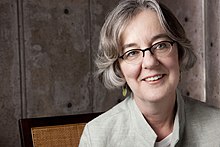Victoria Lundblad
Victoria Joan "Vicki" Lundblad (born August 26, 1952 in Berkeley , California ) is an American molecular and cell biologist at the Salk Institute for Biological Studies . She is known for her work on the genetics, structure and function of telomeres , the structure made up of repetitive DNA and proteins that ensure stability at the ends of chromosomes , but also have important functions for the growth and aging of cells.
Live and act
Lundblad received a Bachelor of Biochemistry from the University of California, Berkeley in 1976 and a Ph.D. from Nancy Kleckner from Harvard University. with a thesis on bacterial transposons .
From 1983 Lundblad worked as a postdoctoral fellow with the later Nobel Prize winner Jack Szostak at Harvard University, where she developed strategies to identify the previously hypothetical telomerase . In 1989 she discovered the Est1 gene , which codes for an activating subunit of telomerase . A second position as a postdoctoral fellow led Lundblad back to the University of California, Berkeley, to the later Nobel Prize winner Elizabeth Blackburn , where she identified a telomerase-independent system for replenishing the telomeres .
In 1991 Lundblad received her first own working group at Baylor University , initially funded by the National Institute on Aging . In large-scale studies with yeast cultures, Lundblad identified three further genes in the telomerase metabolic pathway . Working with Thomas R. Cech from the University of Colorado Boulder , she was able to show that one of these genes, Est2 , codes for the part of telomerase that adds new DNA to the telomeres. In further work she was able to show that certain defects in the DNA repair system simultaneously increase telomerase-independent telomere maintenance, which explains the common origin of two different mechanisms of cancer development .
Lundblad has been a professor at the Salk Institute for Biological Studies since 2006 . She is also an Adjunct Professor at the University of California, San Diego .
In 2008 she was awarded the Pearl Meister Greengard Prize together with Elizabeth Blackburn and Carol Greider for her work on cellular aging and cancer . Szostak, Blackburn and Greider received the 2009 Nobel Prize in Physiology or Medicine for their work on telomeres and telomerase .
Lundblad's recent work deals with the protein Cdc13 , which binds to telomeres and interacts with telomerase.
Victoria Lundblad is married to molecular biologist Lou Zumstein. The couple have no children.
Awards (selection)
- 2003 Fellow of the American Association for the Advancement of Science
- 2008 Pearl Master Greengard Prize
- 2014 Fellow of the American Academy of Microbiology ( American Society for Microbiology )
- 2015 member of the National Academy of Sciences
Web links
- Vicki Lundblad at the Salk Institute for Biological Studies (salk.edu)
- Ingfei Chen: Endless Drive. in: Science online. January 22, 2003
Individual evidence
- ↑ Victoria Joan Lundblad, Born 08/26/1952 in California - CaliforniaBirthIndex.org. In: californiabirthindex.org. Accessed February 27, 2016 .
- ↑ Victoria Lundbald at the University of California, San Diego (ucsd.edu); accessed on November 21, 2014.
- ↑ Recipients of the Pearl Meister Greengard Prize at Rockefeller University (greengardprize.rockefeller.edu); accessed on November 21, 2014.
- ↑ Victoria Lundblad at the American Society for Microbiology (asm.org); accessed on November 21, 2014.
| personal data | |
|---|---|
| SURNAME | Lundblad, Victoria |
| ALTERNATIVE NAMES | Lundblad, Victoria Joan; Lundblad, Victoria J .; Lundblad, Vicki |
| BRIEF DESCRIPTION | American molecular and cell biologist |
| DATE OF BIRTH | August 26, 1952 |
| PLACE OF BIRTH | Berkeley , California |
